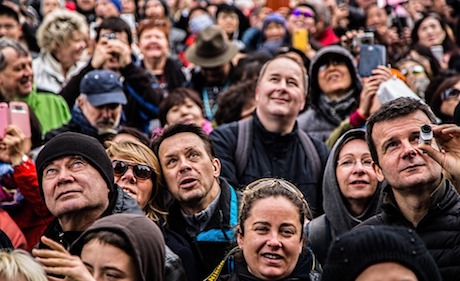[ad_1]
What do their faces say to you?
The Practice:
Receive faces.
Why?
As our ancestors evolved over millions of years in small bands, continually interacting and working with each other, it was vitally important to communicate in hundreds of ways each day. They shared information about external “carrots” and “sticks,” and about their internal experience (e.g., intentions, sexual interest, inclination toward aggression) through gestures, vocalizations – and facial expressions. Much as we developed uniquely complex language, we also evolved the most expressive face in the entire animal kingdom.
Our faces are exquisitely capable of a vast range of expressions, such as showing fear to send signals of alarm, interest to draw others toward an opportunity, or fondness and kindness to increase closeness and the sense of “us.” These expressions include seemingly universal signs of six fundamental emotions – happiness, surprise, fear, sadness, anger, and disgust – as well as more culturally and personally specific expressions. For example, I know that very particular look that crosses my wife’s face when she thinks I’m getting too full of myself!
Of course, there is no sense in having evolved an extraordinary transmitter – the face – unless we also developed an extraordinary receiver: our remarkable capacities to recognize, sense, and infer states of mind in others from subtle and fleeting facial expressions.
So here’s the question: how often and how well do we use this great receiver? Walking down a busy sidewalk, standing in an elevator, waiting in line at a deli: people usually don’t look very much at the faces around them, and if they look, it’s briefly and without really seeing. Or we grow familiar with the faces around us each day at home or work and then tune out, make assumptions – or are simply uncomfortable with what we might see, such as anger, sadness, or a growing indifference. With TV and other media, we’re also bombarded with so many faces from around the world, and it’s easy to feel flooded by them, and increasingly numb or inattentive.
But as natural as this is, you pay a price for it. You miss important information about the wants of others, and their hot buttons, true aims, anxiety or irritability, or good wishes toward you. You lose out on opportunities for closeness and cooperation, and you learn too late about potential problems, including misunderstandings, ruffled feathers, saying yes but meaning no, or simply boredom with what you’re saying.
More generally, you lose out on the chance to feel connected and part of an “us” – which has been so crucial for well-being, stress management, regulating negative emotions, and coping with life throughout our long history on this planet. Further, when you are not attuned to the faces of others, you can’t give them the deeply important experience of feeling recognized, seen, and understood – which, besides not being kind to them, will often boomerang back to hurt you. And in the broadest sense, receiving the faces of others across the world is an important step toward stitching the fabric of humanity closer together, using the ancient threads that bound us to friends and family long ago on the Serengeti plain.
For all these reasons, try to open to and receive the faces of others.
[ad_2]
www.rickhanson.net







